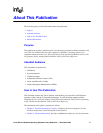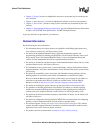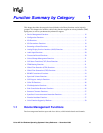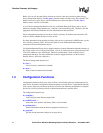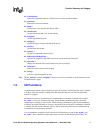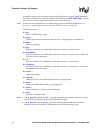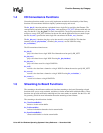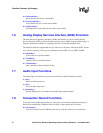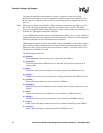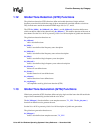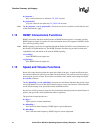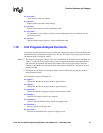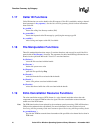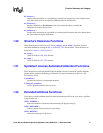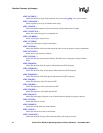
Voice API for Windows Operating Systems Library Reference — November 2003 21
Function Summary by Category
1.9 Cached Prompt Management Functions
The cached prompt management feature enables you to store prompts in on-board memory and
play them from this location rather than from the host disk drive. See the Voice API Programming
Guide for more information about cached prompt management.
dx_cacheprompt( )
downloads voice data (prompts) from multiple sources to the on-board memory
dx_getcachesize( )
returns the size of the on-board memory used to store cached prompts
1.10 Call Status Transition (CST) Event Functions
Call status transition (CST) event functions set and monitor CST events that can occur on a device.
CST events indicate changes in the status of the call, such as rings or a tone detected, or the line
going on-hook or off-hook. See the call status transition structure (DX_CST) description for a full
list of CST events.
The dx_getevt( ) function retrieves CST events in a synchronous environment. To retrieve CST
events in an asynchronous environment, use the Standard Runtime Library event management
functions.
dx_setevtmsk( ) enables detection of CST event(s). User-defined tones are CST events, but
detection for these events is enabled using dx_addtone( ) or dx_enbtone( ), which are global tone
detection functions.
The call status transition event functions are:
dx_getevt( )
gets a CST event in a synchronous environment
dx_sendevt( )
allows inter-process event communication and sends a specified CST event to a specified
device
dx_setevtmsk( )
enables detection of CST events
1.11 TDM Routing Functions
TDM routing functions are used in time division multiplexing (TDM) bus configurations, which
include the CT Bus and SCbus. A TDM bus is resource sharing bus that allows information to be
transmitted and received among resources over multiple time slots.
TDM routing functions enable the application to make or break a connection between voice,
telephone network interface, and other resource channels connected via TDM bus time slots. Each
device connected to the bus has a transmit component that can transmit on a time slot and a receive
component that can listen to a time slot.



